President of the United States
2008/9 Schools Wikipedia Selection. Related subjects: Politics and government
| President of the United States of America |
|
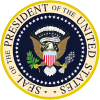 Official seal |
|
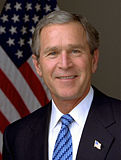 |
|
| Incumbent: George W. Bush |
|
|---|---|
| Inaugural | Constitutional Convention |
| Formation | April 30, 1789 |
| Website | whitehouse.gov/president |
The President of the United States (sometimes abbreviated as POTUS) is the head of state and head of government of the United States. The president is at the head of the executive branch of the federal government, whose role is to enforce national law as given in the Constitution and written by Congress. Article Two of the Constitution establishes the president as commander-in-chief of the armed forces and enumerates powers specifically granted to the president, including the power to sign into law or veto bills passed by both houses of Congress. The president also has the power to create a cabinet of advisers and to grant pardons or reprieves. Finally, with the " advice and consent" of the Senate, the president is empowered to make treaties and appoint federal officers ambassadors, and federal judges, including Justices of the Supreme Court. As with officials in the other branches of the United States government, the Constitution restrains the president with a set of checks and balances designed to prevent any individual or group from taking absolute power.
The president is elected indirectly through the United States Electoral College to a four year term, with a limit of two terms imposed by the Twenty-second Amendment to the Constitution, ratified in 1951. Under this system, each state is allocated a number of electoral votes, equal to the size of the state's delegation in both houses of Congress combined. The District of Columbia is also granted electoral votes, per the Twenty-third Amendment to the Constitution. Voters in nearly all states choose a presidential candidate through the plurality voting system, who then receives all of that state's electoral votes. A simple majority of electoral votes is needed to become president; if no candidate receives that many votes, the election is thrown to the House of Representatives, which votes by state delegation.
While in office, the White House in Washington, D.C. serves as the place of residence for the president; he is entitled to use its staff and facilities, including medical care, recreation, housekeeping, and security services. One of two Boeing VC-25 aircraft, which are extensively modified versions of Boeing 747-200B airliners, serve as long distance travel for the president, and are referred to as Air Force One while the president is on board. A salary of $400,000, along with other benefits, is paid to the president annually.
Since the adoption of the Constitution, forty-two individuals have been elected or succeeded into the presidency, the first being George Washington, serving forty-three presidencies altogether. The current president is George W. Bush, inaugurated on January 20, 2001 to a first term and on January 20, 2005 to a second. His term expires at noon on January 20, 2009, after which he will be succeeded by the winning candidate of the 2008 presidential election. From the middle of the twentieth century, the United States' status as a superpower has led the American president to become one of the world's most well-known and influential public figures.
Origin
The 1783 Treaty of Paris left the United States independent and at peace but with an unsettled governmental structure. The Second Continental Congress had drawn up Articles of Confederation in 1777, describing a permanent confederation but granting to the Congress—the only federal institution—little power to finance itself or to ensure that its resolutions were enforced. In part this reflected the anti-monarchy view of the Revolutionary period, and the new American system was explicitly designed to prevent the rise of an American tyrant to replace the British King.
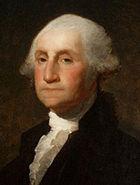
However, during the economic depression due to the collapse of the continental dollar following the Revolutionary War, the viability of the American government was threatened by political unrest in several states, efforts by debtors to use popular government to erase their debts, and the apparent inability of the Continental Congress to redeem the public obligations incurred during the war. The Congress also appeared unable to become a forum for productive cooperation among the States encouraging commerce and economic development. In response a Constitutional Convention was convened, ostensibly to reform the Articles of Confederation but that subsequently began to draft a new system of government that would include greater executive power while retaining the checks and balances thought to be essential restraints on any imperial tendency in the office of the President.
Before the 1788 ratification of the Constitution, there was no comparable figure with executive authority. Individuals who presided over the Continental Congress during the Revolutionary period and under the Articles of Confederation had the title " President of the United States of America in Congress Assembled", often shortened to "President of the United States". They had no important executive power. The President's executive authority under the Constitution, tempered by the checks and balances of the judicial and legislative branches of the federal government, was designed to solve several political problems faced by the young nation and to anticipate future challenges, while still preventing the rise of an autocrat over a nation wary of royal authority.
Qualification, Disqualification and Common Practice
Article Two of the Constitution sets the principal qualifications to be eligible for election as President. A Presidential candidate must:
- be a natural-born citizen of the United States
- be at least thirty-five years old
- have been resident in the United States for at least fourteen years
Additionally, there are two negative qualifications. Under Article One of the United States Constitution, no Presidential candidate can have previously held the office and been removed by conviction for an impeachable offence. And under the Twenty-Second Amendment, no person who has previously served as President or Acting President for more than six years is eligible for election to the Presidency or to the Vice Presidency. Former Presidents who have served less than six years as President or Acting President, however, remain eligible for the presidency (assuming they were not removed from office by the Congress on a bill of impeachment) for one term only; but their eligibilty to serve as Vice President is unlimited, because Amendment XXII only applies to the Presidency.
Foreign-born Americans at the time the Constitution was adopted were also eligible to become President, provided they met the age and residency requirements.
The United States Government was non-partisan prior to 1792, so the Constitution says nothing about political parties. From 1796 to the Civil War, it was common for political parties to fracture and put forward more than one candidate. The classic example is the 1824 election, in which political parties officially played no role because all of the candidates were from the same party.
The Civil War brought home how dangerous political fracture can be for the nation, with the result the two largest parties at the time - Democratic and Republican - remade themselves into broad coalitions of liberals and conservatives. Consequently, all presidents since the Civil War have been nominees of one of these two major political parties.
Nevertheless, there have been six important third-party candidates since the Civil War:
- In 1892, James Weaver ( Populist Party) won 4 states, taking 22 electoral votes
- In 1912, third-party candidate, former Republican and former President Theodore Roosevelt ( Progressive Party aka " Bull Moose Party") actually bested the losing major party candidate, taking 6 states and 88 electoral votes, while sitting President William Howard Taft ( Republican Party) took 2 states and 8 electoral votes - and Democrat Woodrow Wilson took the White House.
- In 1924, Robert M. La Follette, Sr. ( Progressive Party) took 1 state, with 13 electoral votes.
- In 1948, Strom Thurmond ( Dixiecrat) won 4 four states, taking 39 electoral votes
- In 1960, Harry F. Byrd ( Democratic Party) did not run for President but received 15 electoral votes from 3 states. All 8 of Mississippi's electors voted for Byrd as President and Strom Thurmond as Vice President; 6 of Alabama's electors did likewise, while 1 faithless Republican elector from Oklahoma cast his votes for Byrd as President and for Barry Goldwater as Vice President.
- In 1968, Alabama Governor George Wallace ( American Independent Party) won 5 states, taking 46 electoral votes.
In 1992, Reform Party candidate Ross Perot took nearly 19% of the popular vote at national level, but he won no states and, thus, received no electoral votes.
Finally, while they are not in any way requirements:
- Thirty-one of forty-two Presidents had military service records, all but one of them (James Buchanan) serving as an officer
- Most presidents have had prior experience as Senators, Members of Congress, state governors, federal Vice Presidents, or have been Generals in the U.S. Army.
Election
Unlike most other countries using the presidential system, presidents are elected indirectly in the United States. A number of electors, collectively known as the United States Electoral College, select the president instead. Each state is allocated a number of electors, equal to the size of its delegation in both houses of Congress combined. Additionally, the Twenty-third Amendment to the Constitution grants electors to the District of Columbia as if it were a state, with the restriction that it may not have more representation than the least populated state. Electoral apportionment is adjusted every ten years, in alignment with the census. State legislatures are constitutionally empowered to appoint electors, however, all of the fifty states have established their popular selection.
History
Article Two of the Constitution originally established the method of presidential election. It also used an electoral college, but there was a major difference in the voting system. Each elector cast two votes, with the intention that one would be used for a presidential and the other for a vice presidential candidate. The candidate with the highest number of votes would become the president, with the second-place candidate becoming the vice president.
However, the 1796 and 1800 elections highlighted flaws in the electoral system in use at the time. In particular, the tie in the electoral vote that resulted from the lack of separation between presidential and vice presidential votes in the latter election was an issue. The Democratic-Republican Party's candidates, who won the election, were tied with each other, and as a result, the election was thrown to the House of Representatives in the outgoing Federalist Party-controlled 6th Congress. Federalist representatives attempted to elect Aaron Burr, the Democratic-Republican candidate for vice president, over Thomas Jefferson, the presidential candidate. Jefferson eventually won after Alexander Hamilton managed to swing one state delegation's vote to him. As a result, Congress proposed the Twelfth Amendment to the Constitution in 1803, and it was ratified in 1804. This amendment created the electoral system used today.
Campaign
The modern presidential campaign begins before the primary elections, which the two major political parties use to clear the field of candidates in advance of their national nominating conventions, where the most successful candidate is made the party's nominee for president. The party's presidential candidate chooses a vice presidential nominee and this choice is rubber-stamped by the convention. Also, the party establishes a platform on which to base its campaign. Although nominating conventions have a long history in the United States, their substantive importance in the political process has greatly diminished; however, they remain important as a way of energizing the parties for the general election and focusing public attention on the nominees.
Nominees participate in nationally televised debates, and while the debates are usually restricted to the Democratic and Republican nominees, third party candidates may be invited, such as Ross Perot in the 1992 debates. Nominees campaign across the country to explain their views, convince voters, and solicit contributions. Much of the modern electoral process is concerned with winning swing states through frequent visits and mass media advertising drives.
Electoral College
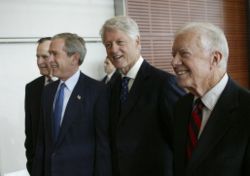
Voters in each of the states elect a president on Election Day, set by law as the first Tuesday after the first Monday in November, once every four years; elections for other offices at all levels of government also occur on this date. Each state holds a number of electoral votes that correspond to electors in the Electoral College. Tickets of presidential and vice presidential candidates are shown on the ballot; each vote for the tickets actually corresponds to a vote for a slate of electors chosen by the candidates' political party. In most states, the ticket that wins the most votes in a state wins all of that state's electoral votes, and thus has their slate of electors chosen to vote in the Electoral College. Maine and Nebraska do not use this method, opting instead to give two electoral votes to the statewide winner and one electoral vote to the winner of each Congressional district. Neither state has split electoral votes between candidates as a result of this system in modern elections. In any case, the winning set of electors meets at their state's capital on the first Monday after the second Wednesday in December, a few weeks after the election, to vote, and sends a vote count to Congress.
The vote count is opened by the sitting vice president, acting in his capacity as President of the Senate, and read aloud to a joint session of the incoming Congress, which was elected at the same time as the president. Members of Congress can object to any state's vote count, provided that the objection is supported by at least one member of each house of Congress. A successful objection will be followed by debate; however, objections to the electoral vote count are rarely raised.
In the event that no candidate receives a majority of the electoral vote, the House of Representatives chooses the president from among the top three contenders. However, the House does not vote normally; instead, each state delegation is given only one vote, marginalizing the importance of more populous states. The vice president is chosen through normal voting in the Senate, where each state delegation is already of equal size.
Rationale
When the Constitution was written, the framers disagreed on the selection of the president: some favored national popular vote, while others wanted Congress to choose the president. The Electoral College was created as a compromise between the two proposals. It gave rural areas and smaller states a slightly larger role in determining the outcome of the election, and it continues to do so today; for example, the largest state by population, California, only has about one electoral vote for every 660,000 residents, while the smallest, Wyoming, has an electoral vote for about every 170,000.
Today, most of the electoral process is a formality in the public eye, as the choice of electors determines the result of the election, with a few exceptions. However, the Twelfth Amendment was written in a time when voters at large had little knowledge of candidates outside their state. As a result, the amendment accommodated this; the electors that voters had chosen were supposed to learn about the other candidates, and make an informed decision that represented the wishes of their constituents. Modern communication has rendered this unnecessary, and as a result, voters now choose between electors that are already pledged to a presidential candidate.
Oath of office and term of office
A president's term of office begins at noon on January 20 of the year following the election. This date, known as Inauguration Day, marks the beginning of the president's and vice president's four-year terms. Before assuming office, the president-elect is constitutionally required to take the presidential oath:
| “ | I do solemnly swear (or affirm) that I will faithfully execute the office of President of the United States, and will to the best of my ability, preserve, protect, and defend the Constitution of the United States. | ” |
Presidents traditionally include "So help me God" at the end of the oath.
Although it is not required, Presidents traditionally used a Bible to take oath of office (some exceptions: Chester A. Arthur in 1881 and Theodore Roosevelt in 1901 did not use a Bible, while Lyndon B. Johnson in 1963 used Roman Catholic missal, because there were no Bible at the Air Force One).
Also oath of office is traditionally administered by Chief Justice of the United States. George Washington was sworn-in by Chancellor of New York Robert Livingston while John Tyler, Millard Fillmore, Chester A. Arthur, Theodore Roosevelt, Calvin Coolidge and Lyndon B. Johnson by lesser-capacity judges.
No constitution or any other act requires that swearing-in must be administered by someone.
George Washington, the first president, set an unofficial term limit of two terms, which was generally followed by subsequent presidents as precedent. After the twelve-year presidency of Franklin D. Roosevelt, who was elected four times, but died shortly after beginning his fourth term, the Twenty-second Amendment to the Constitution was ratified, barring presidents from being elected more than twice, or once if they served more than half of another president's term. Prior to Roosevelt, several presidents had campaigned for a third term, but none were elected. Harry S. Truman, who was president at the time of the amendment's ratification and thus not subject to its terms, also briefly sought a third term before withdrawing from the 1952 race.
Since the amendment's ratification, three presidents have served two full terms: Dwight D. Eisenhower, Ronald Reagan, and Bill Clinton. Richard Nixon was elected to a second term, but resigned before completing it; George W. Bush will become the fourth upon completion of his current term on January 20, 2009. Lyndon B. Johnson was the only president under the amendment to be eligible to serve more than two terms in total, having only served for 14 months following John F. Kennedy's assassination. However, he chose not to run in the 1968 election.
Removal from office
Vacancies in the office of President may arise because of death, resignation, or removal from office. Articles One and Two of the Constitution allow the House of Representatives to impeach high federal officials, including the president, for "treason, bribery, or other high crimes and misdemeanors", and give the Senate the power to remove impeached officials from office, given a two-thirds vote to convict. Two presidents have thus far been impeached by the House, Andrew Johnson in 1868 and Bill Clinton in 1998. Neither was subsequently convicted by the Senate; however, Johnson was acquitted by just one vote.
Per the Twenty-fifth Amendment, the vice president and a majority of the Cabinet may suspend the president from discharging the powers and duties of the office once they transmit to the Speaker of the House and the President pro tempore of the Senate a statement declaring the president's incapacity to discharge the duties of the office. If this occurs, then the vice president will assume the powers and duties of President as Acting President; however, the president can declare that no such inability exists, and resume executing the Presidency. If the vice president and Cabinet contest this claim, it is up to Congress, which must meet within two days if not already in session, to decide the merit of the claim.
The United States Constitution mentions the resignation of the president but does not regulate the form of such a resignation or the conditions for its validity. By Act of Congress, the only valid evidence of the president's decision to resign is a written instrument declaring the resignation signed by the president and delivered to the office of the Secretary of State. The only president to resign was Richard Nixon on August 9, 1974; he was facing likely impeachment in the midst of the Watergate scandal. Just before his resignation, the House Judiciary Committee had reported favorably on articles of impeachment against him.
The Constitution states that the vice president is to be the president's successor in the case of a vacancy. If both the president and vice president are killed or unable to serve for any reason, the next officer in the presidential line of succession, currently the Speaker of the House, becomes acting president. The list extends to the President pro tempore of the Senate after the Speaker, followed by every member of the Cabinet in a set order.
Duties and powers
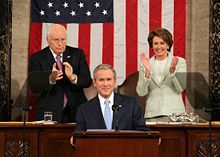
The president is the chief executive of the United States, putting him at the head of the executive branch of the government, whose responsibility is to "take care that the laws be faithfully executed". To carry out this duty, he is given control of the four million employees of the vast executive branch, including one million active duty personnel in the military. Both the legislative and judicial branches maintain checks and balances on the powers of the president, and vice versa.
Various executive and judicial branch appointments are made by presidents, including presidents-elect. Up to 6,000 appointments may be made by an incoming president before he takes office, and 8,000 more may be made while in office. Ambassadors, judges of the federal court system, members of the Cabinet, and other federal officers are all appointed by the president, with the " advice and consent" the Senate, granted by a single majority. Appointments made while the Senate is in recess are temporary and expire at the end of the next session of the Senate. He may also grant pardons, as is often done just before the end of a presidential term.
In addition, while the president cannot directly introduce legislation, he can play an important role in shaping it, especially if the president's political party has a majority in one or both houses of Congress. While members of the executive branch are prohibited from simultaneously holding seats in Congress, they often write legislation and allow a member of Congress to introduce it for them. The president can further influence the legislative branch through the annual constitutionally mandated State of the Union Address, which outlines the president's legislative proposals for the coming year. If Congress passes a bill that the president disapproves of, he may veto it; the veto can be overridden only by two-thirds of both houses of Congress, making it substantially more difficult to enact the law.
Perhaps the most important of all presidential powers is command of the armed forces as commander-in-chief. The framers of the Constitution took care to limit the president's powers regarding the military; Federalist Papers #69 writes in part:
| “ | The President is to be commander-in-chief of the army and navy of the United States. [...] It would amount to nothing more than the supreme command and direction of the military and naval forces [...] while that [the power] of the British king extends to the DECLARING of war and to the RAISING and REGULATING of fleets and armies, all [of] which [...] would appertain to the legislature. | ” |
While the power to declare war is constitutionally vested in Congress, the president commands and directs the military and is responsible for planning military strategy. Congress, pursuant the War Powers Act, must authorize any troop deployments more than 60 days in length. Military spending and regulations are also governed by Congress, providing a check to presidential power. Along with the armed forces, foreign policy is also directed by the president, including the ability to negotiate treaties, which the president then ratifies with consent by two-thirds of the Senate.
Privileges of office

The president is entitled to use the White House as his living and working quarters, and its entire staff and facilities, including medical care, kitchen, housekeeping and security staff. While traveling, the president is able to conduct the functions of the office from one of two custom-built Boeing 747 aircraft, known as Air Force One. The president also utilizes a United States Marine Corps helicopter, designated Marine One when the president is aboard. Similarly, " Navy One", " Army One," and " Coast Guard One" are the call signs used if the president is aboard a craft belonging to these services. For ground travel, the president uses an armored presidential limousine, currently a heavily modified Cadillac DTS which uses the call sign "Cadillac One."
Salary
The First U.S. Congress voted to pay George Washington a salary of $25,000 a year, about $566,000 in 2007 terms. Washington, already a wealthy man, refused to accept his salary; however, he asked for his living expenses to be covered. Theodore Roosevelt spent his entire $50,000 salary on entertaining guests at the White House. John F. Kennedy donated his salary to charities.
| Date established | Salary | Salary in 2007 dollars |
|---|---|---|
| September 24, 1789 | $25,000 | $566,000 |
| March 3, 1873 | $50,000 | $865,000 |
| March 4, 1909 | $75,000 | $1,714,000 |
| January 19, 1949 | $100,000 | $875,000 |
| January 20, 1969 | $200,000 | $1,135,000 |
| January 20, 2001 | $400,000 | $471,000 |
Traditionally, the president is the highest-paid public employee. President Bush currently earns $400,000 per year, along with a $50,000 expense account, a $100,000 nontaxable travel account, and $19,000 for entertainment. The president's salary and total expense account serve as an unofficial cap for all other federal officials' salaries, such as that of the Chief Justice. The most recent raise in salary was approved by Congress and President Bill Clinton in 1999 and came into force in 2001; prior to the change, the president earned $200,000, plus expense accounts. This was needed because other officials who received annual cost-of-living increases had salaries approaching that of the president, and in order to raise their salaries further, his needed to be raised as well. Monetary compensation for the president is minuscule in comparison to the CEOs of most Fortune 500 companies and comparable to that of certain kinds of professionals, such as attorneys and physicians in some parts of the United States. Overall the vast majority of U.S. presidents were very affluent upon entering office and thus were not dependent on the salary.
Prior to passage by Congress of the Former Presidents Act (FPA) in 1958, retired presidents did not receive a pension. All living presidents in 1959 began to receive a pension of $25,000 per year, an office, and a staff. The pension has increased numerous times with Congressional approval. Retired presidents now receive a pension based on the salary of the current administration's cabinet secretaries (Executive Level I), which is $183,500 as of 2007. Some former presidents have also collected congressional pensions. The FPA, as amended, also provides former presidents with travel funds and mailing privileges.
Secret Service
The United States Secret Service is charged with protecting the sitting president and his family. Until 1997, all former presidents and their families were protected by the Secret Service until the president's death. The last president to have lifetime Secret Service protection is Bill Clinton; George W. Bush and all subsequent presidents will be protected by the Secret Service for a maximum of ten years after leaving office. However, debates in Congress have been raised concerning this decision. Following the increase in terrorism and threats to the president in general since 1997, lifetime protection is being reconsidered.
Presidential libraries
Each president since Herbert Hoover has created a repository known as a presidential library for preserving and making available their papers, records, and other documents and materials. Completed libraries are deeded to and maintained by the National Archives; the initial funding for building and equipping each library must come from private, non-federal sources. There are currently twelve presidential libraries in the NARA system. There are also a number of presidential libraries maintained by state governments and private foundations, such as the Abraham Lincoln Presidential Library and Museum, which is run by the State of Illinois.
After the presidency
Some presidents have had significant careers after leaving office. Prominent examples include William Howard Taft's tenure as Chief Justice of the Supreme Court and Herbert Hoover's work on government reorganization after World War II. More recently, Jimmy Carter has become a global human rights campaigner, international arbiter and election monitor, and a recipient of the Nobel Peace Prize. Other former presidents have served in elected office after leaving the White House; Andrew Johnson was elected to the Senate after his term was over, and John Quincy Adams served in the House of Representatives for eighteen years. Grover Cleveland, whose bid for reelection failed in 1888, was elected president again four years later in 1892. John Tyler served in the provisional Confederate States Congress during the Civil War, and was elected to the official Confederate Congress, but died before it convened.
